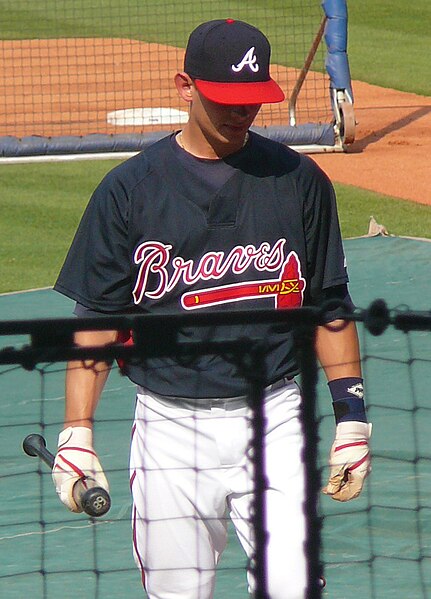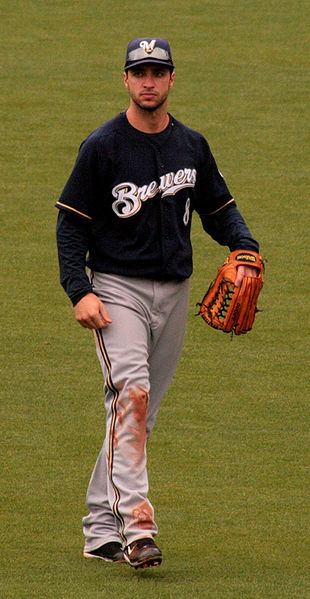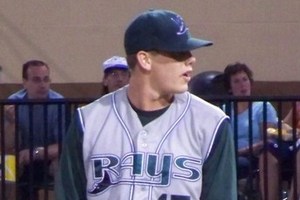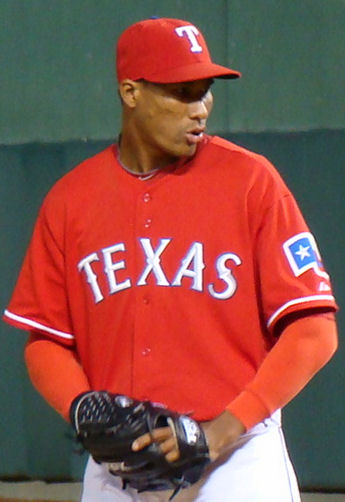A while ago
I looked at how different the 2012 Dodger roster might look as compared to the 2011 version (Damn! Can you believe it is already 2011???).
The Dodgers only have 4 players (Juan Uribe, Chad Billingsley, Ted Lilly and Matt Guerrier) under contract for next season. This doesn't include unproven players under team control ( Kenley Jansen & Jerry Sands) or arbitration eligible players (Kershaw, Kemp & Ethier).
I feel like engaging in a little bit of rosterbation and taking a look at some things that the Dodgers could do for next season.
CATCHER
Well, I'm stumped. And I'm not going to mention
that unmentionable thing.
Right now the Dodgers have
Rod Barajas,
Dioner Navarro,
AJ Ellis and (nominally)
Hector Giminez at catcher. None of these guys looks like the long (or short) term answer for LA.
I'd be surprised to see Giminez last the season with the Dodgers, he's scheduled for a knee surgery and is already a never was. We'll count him out.
Barajas is the starter this season. Barajas is 35 this year and can't have too many more years left to squat. He's an ok player, a fringe starter/back up. In 3158 career plate appearances Barajas has a'mass'ed 8 WAR. That comes out to about 1.1 WAR per 450 trips to the plate. That figures to get less as he gets older.
Dioner Navarro hasn't played yet this season for LA and was (along with Russ Martin) once the Dodgers' Catcher of the Future. He went to Tampa and flamed out after one good (BABIP fueled) year in 2008. He is/was talented. I would like to see him get some playing time this year as there is a (small) chance that he has something left in the tank at only 27 years old.
AJ Ellis is interesting. At 30 years old he is a minor league veteran. As of writing this, Ellis has 62 major league games under his belt. In those 62 games Ellis has 'hit' .257/.346/.294 (Batting Average/On Base Percentage/Slugging). This continues his minor league trend of getting on base via the walk while hitting for
no power. In 1871 minor league at bats Ellis had a line of .277/.398/.375.
So far Ellis has been able to get on base. His plate discipline looks pretty good. In his limited major league at bats he has been better than average at not swinging at pitches out of the zone and making contact when swinging. I'd like to see the Dodgers give Ellis some playing time to see if he can continue to produce this way or if pitchers will start challenging him and quit issuing him walks since he's unlikely to knock too many extra base hits.
There isn't much available in the way of
catching on the free agent market and trades are nearly impossible to speculate on.
I'll certainly take Ellis as my backup next season and give him plenty of opportunity to play and win the starting job if Navarro doesn't work out or another catcher doesn't come available.
We aren't really planning to compete next year and if we are going to compete, we'll have to take some risks and have them payoff. Getting a couple of WAR out of Ellis at the major league minimum would qualify as a payoff.
FIRST BASE
James Loney has to go. From 2008 - 2010 Loney has
the lowest wOBA of any first baseman. Albert Pujols' wOBA over that period-.442, Adam LaRoche-.351, Jorge Cantu-.333, Ty Wigginton-.331,
James Loney-.327
That's right, James Loney is
the worst hitting first baseman in baseball.
But hitting isn't everything. How about defense? Loney is
right in the middle of the pack, costing the Dodgers 4 runs over the last 3 years.
In terms of total production (aka WAR),
not impressive.
I would try desperately to trade Loney this season or off-season. Loney is making $4.75 million this year in his 2nd year of arbitration. To keep Loney next year would cost the Dodgers between $5 and $7 million and a roster spot. I don't need anything back in terms of talent. Just take his salary or I am non-tendering him next off season.
I would sign
Andre Either to a one-year deal worth about $12-15 million to play first base. Andre is in his 3rd year of arbitration eligibility and has received the following salaries: $5.5 million, $9.25 million. He's likely to earn roughly that same amount in arbitration.
Andre is a consistent offensive player as his yearly wOBA shows.
However Ethier plays poor outfield defense. Ethier has a career -33 UZR. That means he has cost his team 33 runs by his poor defensive play. Most of those runs (32) have come since he moved to RF, as he was only -1 as a left fielder.
The worst first baseman in the league cost their teams less than 10 runs a year according to UZR. These are players like Miguel Cabrera, Prince Fielder and Ryan Howard.
Ryan Howard is actually about the same player that we would expect Ethier to be. Last year Howard and Ethier posted identical .367 wOBAs while Howard was worth -13 runs in the field. In so doing, Howard was worth 2.0 WAR. It follows that we would expect Ethier to be worth roughly 2 WAR as well. Ethier was worth 2.1 WAR last year as a RFer, though in fewer PA's than Howard due to an inury. Moving to first would decrease Ethier's value a bit (as more offense is expected of a 1st baseman than a right fielder) but the Dodgers would replace Loney's below average production.
ALBERT PUJOLS OPTION:
Albert Pujols is a free agent after the season. If he makes it to free agency then I'm throwing some money his way to try and bring baseball's best player to Hollywood. LA needs some stars and there aren't many bigger than Albert. With a team that will almost certainly have new owners, what bigger splash would there be than to sign Albert?
SECOND BASE
Ned C signed
Juan Uribe to a 3-year $21 million deal last year to, presumably, play second base. The contract might have been a little bit too high but Uribe is certainly a useful player. He looks to be a capable defender at all 3 infield positions. He has a terrible OBP (.300 on the nose) but hits for some power (career .175 ISO). All together, he's been worth 6 total WAR over the last 2 seasons.
Injuries to Furcal and Blake have forced the Dodgers to use Uribe at 3B and SS opening up some playing time at 2B. I had hoped that that playing time would go to
Ivan DeJesus jr. DeJesus was a one of LA's top prospects before tearing up his leg in 2009. Prior to his injury DeJesus was a shortstop who posted high OBP's.
In 2010 DeJesus came back as a second baseman with an average OBP. DeJesus had mixed reports defensively as a SS so a move to 2B might have been necessary regardless of his injury. But prior to his injury he drew walks about 12% of the time, upon returning, he only walked 6% of the time while maintaining most of the rest of his offensive game. I have no idea what about a leg injury would cause a player to walk that much less. That said, I'd like to see DeJesus get a chance to play in the bigs.
I'm giving DeJesus the chance to be LA's starting second baseman in 2012. Juan Uribe will be my SS and there are always some Jamey Carroll's and Aaron Miles' to backup.
THIRD BASE
I like
Casey Blake. A lot of people were calling for his head after a quite poor 2010 but I wasn't one of them. Blake certainly stepped back after his solid 2009 but that was too be expected.
Blake's Yearly WAR:
2007: 2.3
2008: 2.6
2009: 4.6
2010: 2.8
When looked at like that 2010 doesn't seem bad at all does it? There was certainly a change in his offense
2007: .336
2008: .347
2009: .354
2010: .317
That's real and undeniable.
Blake's power was AWOL:
SLG 2007-2000=.180
SLG 2010=.159
Strikeouts were up:
K% 2007-2009=22.3%
K% 2010=27.1%
Groundballs were up while flyballs were down
GB/FB 2007-2009=.99
GB/FB 2010=1.16
He couldn't hit right-handed pitching
.295 wOBA vs .330 career vs R
.386 wOBA vs .360 career vs L
He didn't have a good year with the bat. However, UZR/150 has loved him since coming to LA
2007 w/Cleveland = -5.1
2008 w/Cleveland = -12.4
2008 w/LA = 7.8
2009 w/LA = 13.1
2010 w/LA = 7.7
Why? I have no idea. Defensive metrics aren't as reliable as offensive metrics, but 2.5 years of data starts to have some validity. Blake has gotten better defensively since coming to LA.
At 37 the chance of decline is quite real. Blake is hit the ball with much less authority last year, and stuck out a lot more. But Blake is only getting paid $5.25 million this year; about what a 1 WAR player would make. Blake almost
tripled that WAR last year. The Dodgers have a team option on Blake for next year for $6 million dollars. Unless Blake falls even farther this season I'd pick up the option. Blake would have to be much worse to be worth less than $6 million, the Dodgers don't have any minor league third basemen ready to play next year, and the free agent third basemen (Aramis Ramirez & Mark DeRosa) have their own issues.
SHORTSTOP
I've already said that Juan Uribe is my starting SS in 2012. But that's not the big story here. The big story at SS is the scrawny 5'11" 150 lb
Dee Gordon. Gordon is highly rated in most Dodger prospect lists and was rated #26 in
Baseball America's Top 100 list for 2011. Gordon's best asset, by far, is his speed. Gordon stole 73 and 53 bases the last two seasons as well as hit 12 and 10 triples. On defense he gets rave reviews for his quickness and range.
Unfortunately, that's where the consensus superlatives end.
There isn't a lot more to Gordon's game than his speed. He's ok, not great, at limiting strikeouts (16%). He doesn't really draw walks (6.5%). He doesn't have much power (.385 SLG%) and he makes a lot of errors (101 over the last 3+ seasons).
The hope is that he can channel his athleticism to improve his defense and cut down on the errors. The hope is that major league pitchers won't overpower the skinny kid since he's not a threat to hit the ball out of the park. By the middle of 2012 we should have a chance to see Gordon in action (full time-I think LA will give him a look this year. Hopefully not till September though) in the big leagues.
Once Gordon is called up Uribe can usurp Casey Blake at 3B or move back to second if DeJesus isn't cutting it.
LEFT FIELD
Didn't take LA long to realize that LF was a mess this season. The platoon between Jay Gibbons and Marcus Thames
never hasn't yet materialized. Gibbons has been on the DL all season because he can't see and Thames has been on the bench a lot because he can't move in LF and he can't hit right-handers (the former being a bigger problem than the later).
So the Dodgers called up prospect
Jerry Sands. I wrote a bit about Sands
here. Since then he hasn't exactly set the world on fire. He's hitting just .133/.233/.269 but he has been able to walk (10%) and is seeing a lot of pitches (5.07 per PA). He's been having some problems swinging out of the strike zone (34%) and making contact (15.6% swings and misses) but that's in only 30 trips to the plate.
I think LA called him up too soon, but he's the left fielder now and is unless he shows that he can't be.
CENTER FIELD
Like left field, center field has one of LA's top prospects about ready to step in. That prospect is
Trayvon Robinson.
Trayvon doesn't always get highly ranked in prospect lists because he doesn't have any one skill that really stands out other than his speed (85 combined steals the last 2 seasons). He looks to be a good defensive center fielder, though is arm is a question. He has some power, though it'll probably be doubles (or triples) power in the big leagues. He's shown good walk rates (14% in AA last year) but strikes out too much (around 28%).
Center fielders aren't typically sluggers. In fact, the average center fielder hit almost exactly at the league average last season. CFers hit .261/.326/.405 while the league average hitter hit .257/.325/.403.
Trayvon's career minor league triple slash stats are: .284/.357/.420 and .293/.399/.438 in a little over a season in AA.
Those numbers don't project to be quite at the level of an average major league hitter, but if he has plus range in center he can certainly still be a major league starter. The strikeout rate is also a concern, as
this article goes into detail about.
Since Trayvon isn't ready, and isn't a guarantee the Dodgers are going to need somebody else who can play center field. I would be in favor of bringing
Tony Gwynn jr back. Gwynn jr is an excellent defender in CF. He has a career URZ/150 of 16.1 as a center fielder.
His bat is another story, of course. Gwynn jr's career wOBA is .293-well below average. He does some things well though. He walks about 10% of the time (8.5% is average) and strikes out only 17% of the tie (20% is average). So he draws walks and puts the ball in play. He, just doesn't put the ball in play hard. Gwynn jr's career ISO and SLG% are just .073 and .319.
Even with his offensive deficiencies Gwynn jr has a been a 2+ WAR player when playing everyday. He signed with LA for $675,000 a year after putting up 2 WAR for the Padres. He was coming off of a down year where he hit just .204/.304/.287 but that was with a .236 BABIP. Gwynn is a better hitter than that. Still, his defense is undervalued so he should be able to be paid less than the value he'll give. He can start in CF for me for a season while we see what Robinson has to offer.
With Robinson, hopefully, manning CF for the foreseeable future, Matt Kemp needs a new home. And that home is...
RIGHT FIELD
Matt Kemp has been the Dodger center fielder since 2008. He has a career .290/.341/.479 line which is much better than what the average center fielder has put up. Unfortunately, his defense doesn't play as well in CF. Kemp's career UZR/150 in CF is -12. Kemp has played 1200+ innings in RF and has a UZR/150 of -5.9. He also has a
very good arm, which should play well in RF.
Moving to RF will decrease Kemp's relative offensive value as the average RFer hit .270/.342/.442. Kemp still comes out ahead though. Kemp's career wOBA is .353 and that includes a terrible 2010. If we say that Kemp is a true .350 wOBA hitter (I think he's higher and the early part of this season seems to agree) and a -6 defender in RF, then he's about a 3.5 WAR player playing full time in RF.
Kemp is in his second year of arbitration and earning about $7 million. He's eligible for arbitration again in 2012. If I'm in charge I'm signing Kemp to a long-term contract. Using the same parameters I have used to analyze the contracts for
Ryan Braun,
Adrian Gonzalez and
Clay Buchholz I get the approximate value that Kemp expects to add to the team to be $98 million over 5 years or $129 million over 7 years. I'm not going to pay Kemp that since LA is assuming all of the risk. I'm going to take 10% off and try and get Kemp to sign a deal around 5 years and $88 million. If his season continues as monstrously as it has began we may have to adjust those numbers up.
That leaves us with the following players under contract and the following batting order:
I'm not going to go through and find all the bench players. That's too dependent on who signs and doesn't sign, who get's non-tendered, who you can pick in the Rule V draft, etc...
I will say that the Dodgers haven't had much on the bench in the way of bats the last few seasons. I'd like to add a couple guys who can pinch hit late in the game and be a threat to hit one out.
Look for another post in the near future about what I'd do with the pitching staff.
*Contract data from
Cot's.
*Stats from
FanGraphs and
Baseball-Reference

























